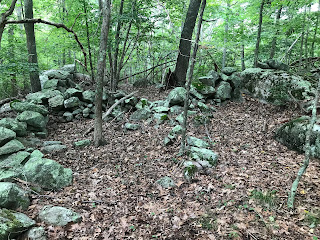Having seen pictures of crowded "cairn fields" from Parker Woodland, it seemed like a place worth visiting. Armed with Norman Muller's advice that the northern part of the woodland was more interesting than the southern part, we started into the park from the north end.
I should mention that neither I nor my wife are in good physical condition. In fact, post pandemic, the priorities are losing weight and getting back into shape. But this was the first such exercise - it is hard getting off Cape - and the walks we took were pretty short.
We started south along the dirt road extension of Thomas Parker Rd. Already before parking I had to stop and photo some of the large piles next to the road:
The property owner is a lucky guy:
Then, as you walk down the dirt road, clusters of rock piles appear on either side:
My wife asked a tough question: "OK so these are very nice and it is fun taking as walk, but what is the point of looking at more rock piles?" I was giving this some thought as we proceeded.
There was a trail cutting perpendicularly across the road and we followed the right hand (western) side trail, down through the woods, past a cluster of old house foundation. The rock piles were everywhere but, to me, seemed most clustered around the old foundations. This does not mean they piles were biproducts of colonial, agrarian, life but that these colonial farms were owned by Indians. The ongoing presence of modern Indians in the area was clarified later, during the second walk at the southern end of the park.

This is such well-trodden territory that it was not hard to find newspaper articles describing the "mysterious" cairns of Parker Woodland. They all reference the groups of rock piles we saw later and do not mention the material at the north end of the park. As suggested by Norman's comment, the woods to the north are much more "full" - with one cluster of rock piles after another, non-stop wherever we walked. But being out of shape we did not walk far and I regret not having the time or energy to explore places between north and south. It is a big patch of woods. My wife was starting to go more slowly.
I wonder if the brainiacs who could not decide whether the crowded cairns on a rocky hillside (see below) were farming biproducts, even noticed these other rock piles in the northern end of the park? The nicest structure I saw was this one (to the rear of previous):
I consider this to be "rectangular", although it was wider at one end than the other. Next to it, was a gully with a stepped sequence of piles:
A lot of what I would call "marker piles":
Some, triangular from above:
There was very little quartz to be seen.
A marvelous place:
But we have not yet answered my wife's question.
We continued west and down, till we got to the edge of a steeper drop-off and, lacking the will to go down and then back up, we reversed direction and went back towards the T. Parker Rd.
We followed the eastern trail a bit before getting too tired out (I know this is pathetic...having driven so far to get here and then being so physically limited) and heading back for the car. The sites thinned out quickly and we ran out of rock piles to see. On the way, a couple of noteworthy things:
Here, at least, was a piece of quartz:
Here was something larger:
And something a bit "box"-like.
Anyway, not much to comment on, the question of "why look at more" still bothering me.
We trudged back to the car, then drove around to the southern end and "Parking Lot #2".





























































